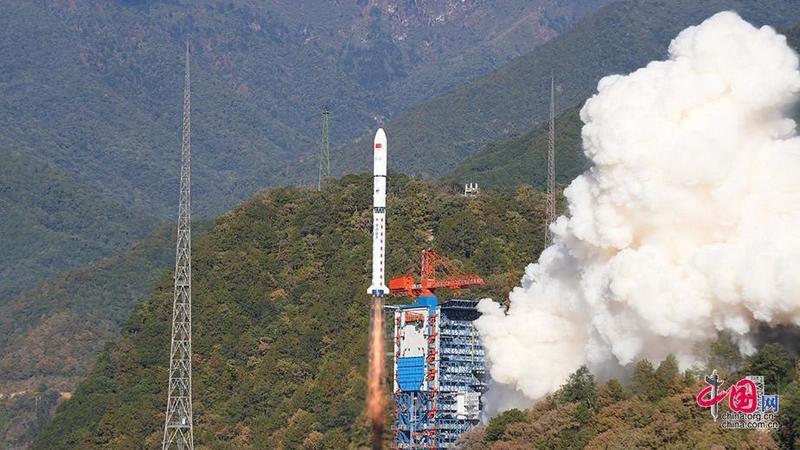 A Long March 2D carrier rocket carrying several remote-sensing satellites blasts off from the Xichang Satellite Launch Center in Southwest China's Sichuan province, Dec 10, 2023. (PHOTO / CHINA.ORG.CN)
A Long March 2D carrier rocket carrying several remote-sensing satellites blasts off from the Xichang Satellite Launch Center in Southwest China's Sichuan province, Dec 10, 2023. (PHOTO / CHINA.ORG.CN)
China used a Long March 2D carrier rocket on Sunday morning to send several remote-sensing satellites into space, marking the 500th launch of the Long March family.
The rocket blasted off at 9:58 am from the Xichang Satellite Launch Center in Southwest China's Sichuan province, spitting red-orange flames and soaring into bright skies, which was caught on video published by the Shanghai Academy of Spaceflight Technology, the maker of the Long March 2D series.
It was China's 59th rocket launch this year and the 13th flight of the Long March 2D model in 2023.
The overall success rate of the Long March fleet is around 97 percent. Of the 500 liftoffs, 297 were carried out by models developed by the China Academy of Launch Vehicle Technology in Beijing and 203 by the Shanghai Academy of Spaceflight Technology.
Both academies are subsidiaries of the State-owned conglomerate China Aerospace Science and Technology Corp, the nation's dominant space contractor.
The Long March 2D is one of the most reliable rockets in China. Since its debut flight in August 1992, the model has been used in 85 flights, all of which have been successful. This has led to it becoming well-known as the "gold medal rocket model" in China's space industry.
The 40.6-meter-tall rocket has a diameter of 3.35 meters and a liftoff weight of 251 metric tons. Its typical tasks are to transport satellites to low-Earth or sun-synchronous orbits.
The launch vehicle is capable of sending a 1.3-ton spacecraft into a sun-synchronous orbit with an altitude of 700 kilometers, or satellites with a combined weight of 4 tons into a low-Earth orbit.
In June, the 76th flight of the Long March 2D series sent a total of 41 satellites into space, setting a new national record for the largest number of spacecraft launched in a single mission.
China launched its first carrier rocket — a Long March 1 — in April 1970 to send its first satellite, Dongfanghong 1, or East Red 1, into space. The mission made China the fifth country capable of building and launching its own carrier rocket to reach Earth's orbit.
It took the Long March family 37 years to conduct its first 100 launches. The next 100 were made in seven-and-a-half years; the third 100 launches in over four years; the fourth 100 launches in two years and nine months; and the most recent 100 missions in only two years.
China has developed and launched more than 20 types of Long March rockets, and 16 of them are in active service.
Zhang Zhi, a senior rocket designer at the China Academy of Launch Vehicle Technology, said that engineers are working on the research and development of the country's next-generation crew-carrying rocket, and the new model, named Long March 10, is expected to be ready for its debut flight around 2027.
"The Long March 10 will be a brand new type of launch vehicle, and will be tasked with launching the country's new-generation manned spacecraft and the lunar landing module," he said.
In addition to the Long March family, there are multiple types of Chinese carrier rockets developed by another State-owned space contractor, China Aerospace Science and Industry Corp, and several private enterprises. So far, Chinese carrier rockets have conducted 564 launches.
The payloads in Sunday's mission — several satellites in the Yaogan 39 series — were manufactured by the Shanghai academy and the China Academy of Space Technology in Beijing, which is also part of China Aerospace Science and Technology Corp.
Remote-sensing satellites refer to those tasked with observing, surveying and measuring objects on land or at sea as well as monitoring weather.
China has so far sent more than 300 civilian remote-sensing satellites into orbit. The Yaogan family is the largest fleet of remote-sensing spacecraft in the country, and their data has been widely used by governments, public service sectors and businesses.


